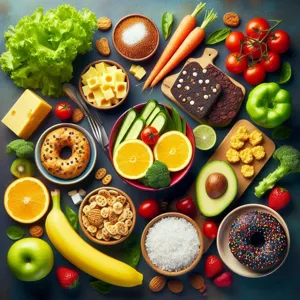In a world where flavor often reigns supreme, the quest to cut down on salt can feel like a daunting challenge.
Yet, as health-conscious individuals strive to lower their salt intake for better heart health and overall wellness, it’s crucial to discover delicious alternatives that don’t compromise taste. This blog post unveils ten simple strategies that will empower you to reduce salt in your meals while still enjoying vibrant, mouthwatering flavors. From harnessing the power of fresh herbs and spices to experimenting with zesty citrus and umami-packed ingredients, you’ll learn how to elevate your culinary creations without the excessive sodium. Whether you’re looking to improve your diet or simply want to explore new ways to season your food, these practical tips will help you savor every bite while keeping your salt levels in check. Get ready to embark on a flavorful journey towards healthier eating!
1. Understanding the Importance of Reducing Salt Intake

reducing salt intake is crucial for maintaining overall health and well-being, yet many people find it difficult to cut back without feeling deprived of flavor. Understanding the importance of this dietary adjustment is the first step in making a lasting change. Excessive salt consumption has been linked to a myriad of health issues, including high blood pressure, heart disease, and stroke. The World Health Organization recommends that adults limit their sodium intake to less than 2,000 milligrams per day—about one teaspoon of salt—yet many of us consume significantly more than that.
Knowing the risks associated with high sodium levels can serve as a powerful motivator. While we often think of salt as simply a seasoning, it plays a much larger role in our health than we may realize. Not only does it contribute to water retention, leading to bloating and discomfort, but it can also have a lasting impact on our cardiovascular system. By reducing salt intake, you’re not just making a dietary change; you’re investing in a healthier lifestyle that can lead to increased energy levels, improved kidney function, and a lower risk of serious health conditions.
However, the good news is that cutting down on salt doesn’t mean sacrificing taste. With a little creativity and some smart substitutions, you can enhance your meals with bold flavors that don’t rely on sodium. Fresh herbs, spices, citrus, and umami-rich ingredients can bring dishes to life, allowing you to enjoy satisfying flavors while keeping your health in check. Understanding the importance of reducing salt is not just about the numbers; it’s about embracing a flavorful journey towards a healthier you.
2. Exploring the Health Risks of Excessive Sodium
Excessive sodium intake is a silent yet potent threat to our health, often lurking in our favorite foods and seasoning blends. Understanding the health risks associated with high sodium consumption is crucial for making informed choices about our diets. The most immediate concern is hypertension, or high blood pressure, which affects nearly half of all adults in the United States. Elevated blood pressure can strain the heart and blood vessels, leading to a host of cardiovascular issues, including heart disease and stroke.
But the dangers of sodium don’t stop there. High salt intake is also linked to kidney disease, as the kidneys work tirelessly to filter excess sodium from the bloodstream. Over time, this can lead to decreased kidney function or even kidney stones, which are known for their painful symptoms. Moreover, research suggests that a diet high in sodium may contribute to conditions like osteoporosis, where excessive salt can cause calcium to be leached from the bones. This not only weakens bones but also increases the risk of fractures, particularly in older adults.
For those who suffer from certain conditions, such as heart failure or edema, managing sodium intake becomes even more critical. A high-sodium diet can exacerbate fluid retention, leading to uncomfortable swelling and increased strain on the heart. By reducing sodium consumption, individuals can often find relief from these symptoms and improve their overall well-being.
Understanding these risks highlights the importance of finding flavorful alternatives to salt without compromising taste. By exploring fresh herbs, spices, and other natural flavor enhancers, we can create vibrant meals that are not only satisfying but also align with our health goals. The journey to reducing sodium doesn’t have to be bland—it’s an opportunity to discover a world of flavor that celebrates health without sacrifice.
3. Start with Fresh Ingredients: Embrace Whole Foods

When it comes to cutting down on salt without sacrificing flavor, starting with fresh ingredients is a game changer. Embracing whole foods is not just a healthy choice; it’s a flavorful one too. Fresh fruits, vegetables, herbs, and spices are naturally bursting with flavors that can elevate your dishes beyond the need for added salt.
Imagine walking through a vibrant farmer’s market, where the air is filled with the enticing aromas of ripe tomatoes, fragrant basil, and zesty citrus. These ingredients don’t just add color to your meal; they bring a depth of flavor that processed foods often lack. For instance, a ripe tomato can offer a sweet, tangy essence that transforms a simple salad or pasta dish, making it delightful without the need for an extra sprinkle of salt.
Herbs and spices, in particular, are your best allies in this journey. Fresh basil, cilantro, rosemary, and thyme can infuse your meals with rich layers of flavor, while spices like cumin, paprika, and black pepper can add warmth and complexity. Consider a roasted vegetable medley drizzled with olive oil and sprinkled with fresh herbs—each bite is a celebration of taste that stands strong on its own, needing no additional salt.
Moreover, whole foods are not only more nutritious, but they also offer a satisfying texture that processed options can rarely match. Crunchy fresh bell peppers, juicy cucumbers, and creamy avocados provide a sensory experience that enhances your dishes and keeps them interesting. By prioritizing these fresh ingredients, you’ll find that the natural flavors shine through, allowing you to cut back on salt while still creating delicious, satisfying meals that leave you feeling great.
So next time you’re planning your meals, remember: the fresher the ingredient, the more flavorful your dish. Embrace whole foods, and watch your culinary creations flourish.
4. Experimenting with Herbs and Spices as Flavor Boosters
When it comes to cutting down on salt without sacrificing flavor, experimenting with herbs and spices is one of the most rewarding strategies you can embrace. These natural flavor enhancers can transform a bland dish into a culinary masterpiece, inviting vibrant layers of taste that excite the palate.
Imagine reaching for a handful of fresh basil, its aromatic leaves releasing a sweet, peppery fragrance as you tear them into your pasta dish. Or consider the warm, earthy notes of cumin and coriander that can elevate a simple bean stew into an exotic experience. The right combination of herbs and spices can not only replace the savory depth that salt provides but also introduce new flavors you never thought possible.
Begin by exploring different flavor profiles. If you’re cooking Italian, consider rosemary, thyme, and oregano; for a Middle Eastern flair, try za’atar or sumac. Asian dishes can benefit greatly from ginger, garlic, and lemongrass, while a sprinkle of smoked paprika can add depth to any savory recipe. Don’t hesitate to mix and match—sometimes, the most unexpected pairings lead to the most delightful results!
To maximize the benefits of your herbs and spices, consider toasting whole spices in a dry pan to release their essential oils, or using fresh herbs toward the end of cooking to ensure their bright flavors shine through. Incorporating acidic ingredients like lemon juice or vinegar can further enhance the taste, creating a balanced dish that beckons for seconds.
By dedicating some time to experiment with herbs and spices, you not only reduce your sodium intake but also embark on a flavorful journey that can reinvigorate your cooking. So grab those jars from your pantry, try out new combinations, and let your creativity flourish—your taste buds will thank you!
5. The Power of Acid: Using Citrus and Vinegars

When it comes to enhancing flavor without the need for excess salt, few ingredients pack as much punch as citrus fruits and vinegars. The bright, tangy profiles of these acids can elevate any dish, creating a complex taste experience that often rivals the richness traditionally provided by salt.
Citrus fruits like lemons, limes, oranges, and grapefruits offer not only their zesty juices but also their fragrant zest, which can add an aromatic layer to your meals. A squeeze of fresh lemon or lime juice over grilled vegetables or fish can bring out their natural sweetness while simultaneously adding a refreshing lift. Similarly, incorporating citrus zest into marinades or dressings adds an invigorating burst that tantalizes the taste buds.
Vinegars, from classic balsamic to zesty apple cider or tangy rice vinegar, provide another avenue for flavor enhancement. A splash of vinegar in a salad dressing can brighten the greens, while a drizzle over roasted vegetables can transform a simple dish into a gourmet experience. The acidity found in vinegar can also help to balance out richness in heavier dishes, such as creamy pastas or hearty stews, making them feel lighter and more vibrant.
The power of acid is all about contrast. By introducing these bright flavors into your cooking, you can create depth and complexity that make the absence of salt feel almost unnoticeable. So, next time you’re whipping up a meal, don’t shy away from reaching for that lemon or vinegar bottle—embrace the zest and tang that can elevate your dishes to new heights without compromising on flavor.
6. Utilizing Cooking Techniques to Enhance Flavor
When it comes to cutting down on salt, the way you cook can make all the difference in preserving and enhancing the flavor of your dishes. By employing various cooking techniques, you can coax out the natural flavors of your ingredients, creating depth and complexity without relying heavily on salt.
**Searing and Browning:** One of the most effective methods is searing, which involves cooking food at high heat to create a caramelized crust. This technique is perfect for proteins like chicken, beef, or fish. The Maillard reaction—the chemical reaction that occurs when proteins and sugars are exposed to heat—adds a rich, savory flavor that can elevate your dish. Just a sprinkle of herbs or a squeeze of lemon afterwards can enhance this flavor further without the need for added salt.
**Roasting:** Roasting vegetables in the oven allows their natural sugars to caramelize, intensifying their sweetness and flavor. Toss vegetables like Brussels sprouts, carrots, or bell peppers with a little olive oil and your favorite spices, then roast them until they’re golden brown. The results are deliciously sweet and savory, making them a satisfying side that doesn’t miss the salt.
**Infusing:** Infusion is another technique that can enhance flavor significantly. Consider infusing oils or vinegars with aromatics such as garlic, herbs, or citrus peels. These infused ingredients can then be drizzled over your dishes to impart a burst of flavor without the need for salt. For instance, a drizzle of garlic-infused olive oil over pasta or a salad can provide a robust flavor profile that delights the palate.
**Using Acid:** Don’t underestimate the power of acidity! Ingredients like lemon juice, vinegar, or lime juice can brighten a dish and make flavors pop. A splash of balsamic vinegar on roasted vegetables or a squeeze of fresh lime juice in a fish taco can create an explosion of flavor that often compensates for the lack of salt.
**Herbs and Spices:** While not strictly a cooking technique, using fresh or dried herbs and spices effectively can transform a dish. Instead of reaching for the salt shaker, experiment with herbs like rosemary, thyme, or basil. Spices like cumin, paprika, and coriander can also add warmth and depth to your meals. When combined with the right cooking techniques, these flavor boosters can turn even the simplest of dishes into a culinary delight.
By incorporating these cooking techniques, you can cut down on salt while still enjoying vibrant, flavorful meals that satisfy your taste buds. The key lies in being adventurous in the kitchen and exploring the myriad of flavors that can be unlocked through thoughtful preparation and cooking methods.
7. Incorporating Aromatics: Onions, Garlic, and More

When it comes to enhancing flavor while reducing sodium, incorporating aromatics like onions, garlic, shallots, and leeks into your cooking can be a game-changer. These ingredients are not just the foundation of countless dishes; they possess unique flavors that can elevate your meals without the need for added salt.
Onions, whether they are yellow, red, or sweet varieties, provide a natural sweetness that develops beautifully when sautéed. Their caramelization releases deep, rich flavors that can make any dish feel more indulgent. Garlic, on the other hand, brings a robust and slightly spicy kick that can transform a simple pasta or vegetable dish into something extraordinary. Roasted garlic, with its mellow and creamy texture, can be spread on bread or blended into sauces, adding a layer of complexity that distracts from the absence of salt.
Shallots offer a more delicate flavor profile, with hints of both onion and garlic, making them perfect for dressings or as a finishing touch to a dish. Additionally, herbs and spices can amplify the flavor profile even further. Fresh herbs like basil, cilantro, or thyme add brightness and freshness, while spices such as paprika, cumin, and black pepper contribute warmth and depth.
Experimenting with these aromatics allows you to develop a repertoire of flavorful combinations tailored to your taste. Try adding a generous amount of chopped onions and garlic to your stir-fry, or sauté shallots in olive oil before tossing them with roasted vegetables. Not only will your meals be delicious, but they will also be healthier, demonstrating that you can indeed cut down on salt without sacrificing flavor. Embrace the power of aromatics and unlock a world of taste in your kitchen!
8. Choosing Low-Salt Alternatives: Read Labels Carefully
When it comes to cutting down on salt, one of the most effective strategies is to choose low-sodium alternatives whenever possible. However, not all low-sodium products are created equal, and this is where careful label reading becomes essential. Many consumers are surprised to discover that what seems like a healthy, low-sodium option can still contain a surprising amount of salt, especially when it comes to processed foods.
Start by familiarizing yourself with the nutritional information on the packaging. Look beyond the bold “low-sodium” label and delve into the actual sodium content per serving. A product may claim to be low in sodium, but if the serving size is unrealistically small, you might end up consuming more sodium than you bargained for. Aim for items that contain less than 140 mg of sodium per serving, which is generally considered a low-sodium option.
Additionally, keep an eye out for hidden sources of sodium. Ingredients such as soy sauce, pickles, and certain condiments can pack a salty punch, even in small amounts. Opt for low-sodium versions of these staples, or consider making your own at home. For example, homemade salad dressings can be a flavorful substitute that allows you to control the salt content.
In your quest to reduce salt, don’t overlook the importance of flavor. Many low-sodium alternatives are enhanced with herbs, spices, and other flavoring agents that can elevate your dishes without the need for added salt. Experiment with fresh ingredients like garlic, lemon juice, and various spices to keep your meals vibrant and exciting. By reading labels carefully and making informed choices, you can successfully reduce your sodium intake while still enjoying delicious, satisfying meals.
9. Creative Use of Flavorful Broths and Stocks
When it comes to reducing salt in your cooking, flavorful broths and stocks can be your best allies. They serve as a robust foundation that infuses dishes with depth and richness, allowing you to enhance flavors without relying solely on salt. Instead of reaching for that salt shaker, consider the myriad of options available to you in the world of broths and stocks.
Start with homemade broths, crafted from fresh vegetables, herbs, and spices. A simple vegetable broth simmered with aromatic ingredients like garlic, onions, and carrots can provide a natural sweetness and complexity that elevates your dish. For an extra kick, toss in a few sprigs of fresh herbs such as thyme or rosemary, or a splash of vinegar to balance the flavors.
If time is of the essence, store-bought options can also be a lifesaver; just be sure to choose low-sodium varieties. These can be used as a base for soups, stews, and sauces or even as a cooking liquid for grains and legumes. Imagine cooking your quinoa in a rich mushroom broth, allowing it to absorb that umami flavor without the additional salt.
For an unexpected twist, explore international broths that can add unique flavors to your meals. A fragrant coconut milk broth infused with lemongrass and ginger can transform a simple chicken stir-fry into a vibrant culinary experience. Alternatively, a spicy kimchi broth can bring warmth and zest to your ramen or noodle dishes.
Experiment with flavor layering by starting with your broth and then building upon it with aromatics like sautéed onions, garlic, or leeks. Incorporate spices such as cumin, coriander, or smoked paprika to create layers of taste that distract from the absence of salt. Finally, consider finishing your dishes with a drizzle of citrus juice or a sprinkle of fresh herbs to brighten the flavors and leave your taste buds satisfied.
By creatively using flavorful broths and stocks, you can cut down on salt while still delivering delicious, satisfying meals that encourage healthy eating without compromising on taste. Embrace the art of broth-making, and watch as your dishes come alive with flavor!
10. Enhancing Flavor with Fermented Foods
Incorporating fermented foods into your diet is a delicious and nutritious way to enhance flavor while reducing your reliance on salt. Fermentation not only transforms food but also amplifies its natural taste, offering a complex array of flavors that can elevate your meals without the need for excessive sodium.
Think about the tangy punch of kimchi or the sharpness of a well-aged sauerkraut. These fermented delights are bursting with umami, the savory fifth taste that can make dishes truly irresistible. A simple spoonful of kimchi can add a zesty kick to tacos, while sauerkraut can elevate a humble sandwich to new heights.
Additionally, fermented foods are often rich in probiotics, which are beneficial for gut health. This dual benefit means you’re not just cutting down on salt; you’re also nourishing your body. You can easily incorporate items like miso, tempeh, or yogurt into your cooking. Miso, for example, can be whisked into dressings or soups, providing a depth of flavor that rivals the saltiest of broths.
Experimenting with fermented condiments can also provide unexpected flavor profiles. Consider using pickled vegetables to add crunch and acidity to salads or grain bowls, or drizzle a bit of kimchi juice over roasted vegetables for a delightful contrast.
By embracing the vibrant world of fermented foods, you can open up a treasure trove of flavors that will keep your taste buds satisfied while you cut back on salt. So, dive into the world of fermentation and watch your meals transform from ordinary to extraordinary!
11. Mindful Seasoning: Techniques for Reducing Salt Gradually
When it comes to reducing salt in your cooking, adopting mindful seasoning techniques can be a game-changer. The goal is to gradually decrease your sodium intake without sacrificing the flavors that make your meals enjoyable. Start by experimenting with the concept of layering flavors. Instead of relying solely on salt, enhance your dishes with a variety of aromatic herbs and spices. Fresh herbs like basil, cilantro, or parsley can brighten up any dish, while spices such as cumin, paprika, and chili powder add depth and warmth.
Another approach is to use acid to bring balance and brightness to your meals. A splash of lemon juice, a drizzle of balsamic vinegar, or even a sprinkle of citrus zest can elevate flavors, making it easier to reduce your reliance on salt. Likewise, consider incorporating umami-rich ingredients like mushrooms, tomatoes, or nutritional yeast, which can impart a savory taste without the need for added sodium.
As you embark on this journey of mindful seasoning, take the time to taste your food at various stages of preparation. This practice not only helps you recognize the natural flavors of your ingredients but also allows you to adjust your seasoning gradually, giving your palate time to adapt. Remember, cooking is an art, and by experimenting with different techniques and combinations, you can create delicious dishes that are both satisfying and lower in salt. Ultimately, mindful seasoning empowers you to enjoy flavorful meals while prioritizing your health.
12. Flavorful Cooking Methods: Roasting, Grilling, and Sautéing
When it comes to reducing salt without sacrificing flavor, the cooking methods you choose can make all the difference. Roasting, grilling, and sautéing not only enhance the natural flavors of your ingredients but also create a delightful aroma that can elevate your meals to new heights.
**Roasting** is a fantastic technique that caramelizes the natural sugars in vegetables and proteins, imparting a rich depth of flavor. As you toss your favorite vegetables—like carrots, bell peppers, and Brussels sprouts—with a splash of olive oil and your choice of herbs, the oven works its magic. The high heat transforms those humble ingredients, developing a sweet, nutty profile that can stand strong on its own, even sans salt. Imagine biting into a perfectly roasted cauliflower steak, its edges beautifully charred and its interior tender—flavor-packed and utterly satisfying.
**Grilling,** on the other hand, introduces a smoky essence that can elevate any dish. The act of cooking over an open flame creates a unique flavor profile that enhances meats, seafood, and veggies alike. Marinate your proteins in citrus juices, garlic, and fresh herbs to amplify flavor without relying on salt. A grilled lemon-herb chicken, with its juicy, succulent texture and enticing aroma, showcases how grilling can transcend the need for extra seasoning.
**Sautéing** is another excellent method that preserves the integrity and taste of fresh ingredients. Using a small amount of healthy oil, quickly cooking vegetables over high heat creates a wonderful contrast of textures and flavors. Toss in aromatic ingredients like garlic, ginger, or onions, and you’ll create a fragrant base that enhances whatever you cook next. Think of a sautéed spinach dish—bright, vibrant, and brimming with flavor, it can easily shine without a sprinkle of salt.
Incorporating these flavorful cooking methods into your culinary repertoire not only helps you cut down on salt but also encourages a deeper appreciation for the natural flavors of your ingredients. By experimenting with roasting, grilling, and sautéing, you’ll discover that delicious meals can be crafted without the reliance on salt, all while keeping your taste buds excited and satisfied.
13. Finding Balance: How to Taste as You Cook
Finding balance in your cooking is crucial, especially when you’re trying to reduce salt while still packing a punch of flavor. One of the most effective techniques is to taste as you go, a practice that not only enhances your culinary skills but also helps you develop a deeper understanding of how different ingredients interact.
Start by sampling your dish at various stages of the cooking process. As you sauté your vegetables, for instance, take a moment to taste them before adding any seasoning. This allows you to appreciate their natural flavors and sweetness, which can often shine through without the need for extra salt.
When you’re making a broth or sauce, taste it frequently to gauge its development. If it seems flat, consider adding a splash of acidity—like lemon juice or vinegar—or a sprinkle of herbs and spices instead of reaching for the salt shaker. Fresh herbs such as basil, cilantro, or parsley can elevate your dish, bringing a burst of freshness that helps compensate for the lower sodium content.
Additionally, keep in mind that flavors can intensify as they cook, so hold off on final seasonings until your dish is nearly complete. This practice not only encourages a mindful cooking approach but also allows you to adjust flavors incrementally, ensuring a well-balanced final product. By honing your tasting skills, you create a more intuitive cooking experience that celebrates the natural essence of your ingredients while crafting delicious meals that are kinder to your health. So, the next time you’re in the kitchen, remember: a little patience and a discerning palate can go a long way in achieving flavor without the excess salt.
14. The Role of Umami in Reducing Salt Dependence
Umami, often referred to as the “fifth taste,” is a powerful ally in your quest to reduce salt while still delivering a satisfying flavor profile. This savory taste is found in a variety of foods, including tomatoes, mushrooms, aged cheeses, soy sauce, and fermented products like miso. By harnessing the essence of umami, you can enhance the depth and richness of your dishes, allowing you to cut back on salt without compromising on taste.
When you incorporate umami-rich ingredients into your cooking, you create a complex flavor base that can mask the absence of salt. For example, adding a splash of soy sauce or a sprinkle of nutritional yeast to your recipes can provide that savory kick that makes your taste buds sing. Roasting vegetables like bell peppers, carrots, and onions can also elevate their natural sweetness and umami characteristics, creating a robust flavor that needs less seasoning.
Experimenting with umami is not just about adding flavor; it’s about understanding how it can transform your meals. Consider using mushrooms in sauces, incorporating sun-dried tomatoes into pasta dishes, or blending in some miso paste into dressings and marinades. These ingredients can infuse your dishes with a savory richness that leaves you feeling satisfied, reducing the urge to reach for the salt shaker.
Additionally, umami can enhance the perception of flavor intensity, meaning you might find that you need less salt than before. This not only benefits your health by lowering sodium intake but also encourages a more diverse palate as you explore new ingredients and cooking techniques. Embracing umami in your cooking is a delicious way to elevate your meals while maintaining a heart-healthy approach. So, the next time you’re in the kitchen, remember that umami is not just a flavor; it’s a flavorful solution to cutting down on salt!
15. Tips for Dining Out: Making Informed Choices
dining out can often present challenges for those looking to cut down on salt without sacrificing flavor. However, with a little knowledge and some strategic choices, it’s entirely possible to enjoy your meal while keeping sodium levels in check.
Before you even step foot in the restaurant, consider researching the menu online. Many establishments provide nutritional information on their websites, allowing you to pinpoint lower-sodium dishes in advance. Look for options that emphasize fresh ingredients, as these are often prepared with less salt compared to heavily processed foods.
Once you’re seated, don’t hesitate to communicate with your server. Politely ask about the preparation methods and request that your dish be made with less salt or with sauce served on the side. This simple tweak can dramatically reduce sodium without compromising the overall taste.
When it comes to appetizers, opt for salads or vegetable-based dishes, and ask for dressings or dips to be served on the side, so you can control the amount used. Steer clear of fried or heavily seasoned items, which are often high in hidden salt.
As you explore the main course options, consider grilled, baked, or steamed dishes instead of fried or sautéed ones. These cooking methods typically require less salt while still delivering robust flavors through herbs, spices, and citrus. When ordering seafood, choose items that are simply seasoned rather than those that come with rich sauces or marinades.
Lastly, don’t forget about beverages! Choose water, herbal teas, or fresh juices to avoid the added sodium often found in soft drinks and cocktails. By making these informed choices, you can savor your dining experience while sticking to your goal of reducing salt intake, proving that a flavorful meal doesn’t have to come at the expense of your health. Enjoy the adventure of exploring new flavors that are both delicious and mindful of your dietary needs!
As we wrap up our exploration of the 10 simple strategies to cut down on salt without sacrificing flavor, we hope you feel inspired and empowered to make tasty, heart-healthy choices in your cooking. Reducing salt doesn’t mean compromising on the deliciousness of your meals; instead, it opens up a world of flavors through herbs, spices, and creative cooking techniques. By incorporating these strategies into your daily routine, you can enhance your dishes while promoting better health for yourself and your loved ones. So, roll up your sleeves and get ready to experiment in the kitchen—your taste buds and heart will thank you! Remember, every small step counts toward a healthier lifestyle, and we can’t wait to hear about the flavorful masterpieces you create along the way!








